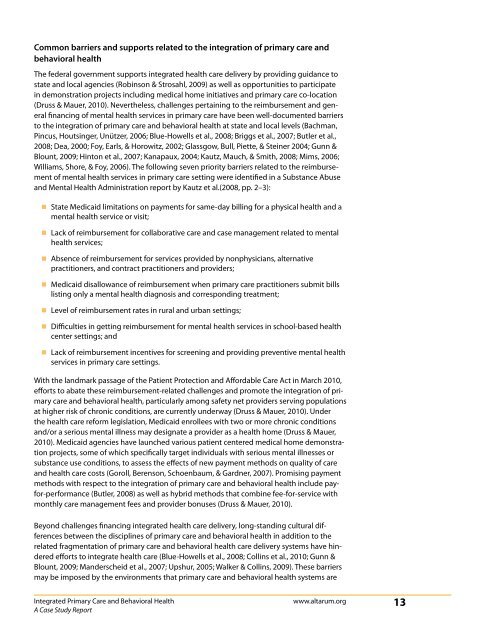A Case Study Report - Altarum Institute
A Case Study Report - Altarum Institute
A Case Study Report - Altarum Institute
You also want an ePaper? Increase the reach of your titles
YUMPU automatically turns print PDFs into web optimized ePapers that Google loves.
Common barriers and supports related to the integration of primary care and<br />
behavioral health<br />
The federal government supports integrated health care delivery by providing guidance to<br />
state and local agencies (Robinson & Strosahl, 2009) as well as opportunities to participate<br />
in demonstration projects including medical home initiatives and primary care co-location<br />
(Druss & Mauer, 2010). nevertheless, challenges pertaining to the reimbursement and general<br />
financing of mental health services in primary care have been well-documented barriers<br />
to the integration of primary care and behavioral health at state and local levels (Bachman,<br />
Pincus, Houtsinger, unützer, 2006; Blue-Howells et al., 2008; Briggs et al., 2007; Butler et al.,<br />
2008; Dea, 2000; Foy, earls, & Horowitz, 2002; Glassgow, Bull, Piette, & Steiner 2004; Gunn &<br />
Blount, 2009; Hinton et al., 2007; Kanapaux, 2004; Kautz, Mauch, & Smith, 2008; Mims, 2006;<br />
Williams, Shore, & Foy, 2006). The following seven priority barriers related to the reimbursement<br />
of mental health services in primary care setting were identified in a Substance Abuse<br />
and Mental Health Administration report by Kautz et al.(2008, pp. 2–3):<br />
State Medicaid limitations on payments for same-day billing for a physical health and a<br />
mental health service or visit;<br />
Lack of reimbursement for collaborative care and case management related to mental<br />
health services;<br />
Absence of reimbursement for services provided by nonphysicians, alternative<br />
practitioners, and contract practitioners and providers;<br />
Medicaid disallowance of reimbursement when primary care practitioners submit bills<br />
listing only a mental health diagnosis and corresponding treatment;<br />
Level of reimbursement rates in rural and urban settings;<br />
Difficulties in getting reimbursement for mental health services in school-based health<br />
center settings; and<br />
Lack of reimbursement incentives for screening and providing preventive mental health<br />
services in primary care settings.<br />
With the landmark passage of the Patient Protection and Affordable Care Act in March 2010,<br />
efforts to abate these reimbursement-related challenges and promote the integration of primary<br />
care and behavioral health, particularly among safety net providers serving populations<br />
at higher risk of chronic conditions, are currently underway (Druss & Mauer, 2010). under<br />
the health care reform legislation, Medicaid enrollees with two or more chronic conditions<br />
and/or a serious mental illness may designate a provider as a health home (Druss & Mauer,<br />
2010). Medicaid agencies have launched various patient centered medical home demonstration<br />
projects, some of which specifically target individuals with serious mental illnesses or<br />
substance use conditions, to assess the effects of new payment methods on quality of care<br />
and health care costs (Goroll, Berenson, Schoenbaum, & Gardner, 2007). Promising payment<br />
methods with respect to the integration of primary care and behavioral health include payfor-performance<br />
(Butler, 2008) as well as hybrid methods that combine fee-for-service with<br />
monthly care management fees and provider bonuses (Druss & Mauer, 2010).<br />
Beyond challenges financing integrated health care delivery, long-standing cultural differences<br />
between the disciplines of primary care and behavioral health in addition to the<br />
related fragmentation of primary care and behavioral health care delivery systems have hindered<br />
efforts to integrate health care (Blue-Howells et al., 2008; Collins et al., 2010; Gunn &<br />
Blount, 2009; Manderscheid et al., 2007; upshur, 2005; Walker & Collins, 2009). These barriers<br />
may be imposed by the environments that primary care and behavioral health systems are<br />
Integrated Primary Care and Behavioral Health www.altarum.org 13<br />
A <strong>Case</strong> <strong>Study</strong> <strong>Report</strong>


